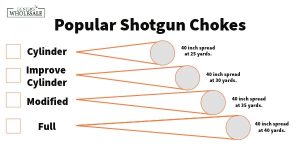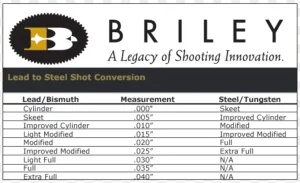Optimal Shotgun Choke Constrictions for Clay Targets
Shotgun choke constrictions play an essential role in trap, skeet, and sporting clays. The choice of choke can make or break a shooter’s performance, affecting the spread and density of the pellet pattern as it leaves the barrel.
Understanding Shotgun Choke Constrictions
Shotgun choke constrictions are designed to manipulate the spread of pellets, thereby determining the effective range of the shotgun. The level of constriction in a choke dictates the degree to which the shot will be condensed upon exiting the barrel. Generally, the more constricted the choke, the tighter the shot pattern will be, and the further the effective range.
Chokes come in several varieties, including cylinder, improved cylinder, modified, improved modified, full, and extra full. The cylinder choke provides no constriction, resulting in a wide spread, while the extra full choke creates a highly concentrated shot pattern optimal for long-range shooting. The other types offer varying degrees of constriction and are suited to different shooting situations.

Understanding the nuances of each choke type and how it affects the shot pattern is crucial for choosing the right choke for your particular shooting style and conditions. Factors such as the type of shotgun, the kind of shot, and the distance to the target all influence the optimal choke selection.
Evaluating the Best Chokes for Clay Targets
Determining the best choke for clay targets depends largely on the specific shooting discipline and the shooter’s skill level. For skeet shooting, where targets are typically closer and moving rapidly across the shooter’s field of view, a less constricted choke like a cylinder or improved cylinder is often ideal. These chokes allow a wide spread of shot, increasing the chances of hitting the target.
In trap shooting, where the targets are typically further away and moving away from the shooter, a more constricted choke like a modified or full choke may be preferable. These chokes deliver a tighter shot pattern for longer distances, increasing the likelihood of a successful hit.

In sporting clays, the variety and unpredictability of the targets mean that a versatile choke is often the best choice. An improved cylinder or modified choke provides a balance of spread and range suitable for most situations. However, many sporting clay shooters prefer to use interchangeable chokes to adapt to the diverse challenges this discipline presents.
Impact of Choke Constrictions on Performance
The effect of choke constrictions on shooting performance is significant. The right choke can enhance the shooter’s accuracy and consistency, while the wrong one can lead to missed targets and frustration. However, it’s important to note that choke selection is just one piece of the puzzle. One’s shooting technique, the quality of the shotgun, and the type of shot also play vital roles in the overall performance.
The choke’s primary function is to control the shot spread, allowing the shooter to optimize their shot for the specific conditions they’re facing. A well-chosen choke can offer a significant advantage, particularly in competitive shooting where every hit counts. Conversely, using a choke that’s too tight for close targets or too loose for distant ones can severely hamper the shooter’s effectiveness.
It’s also worth noting that the choke’s influence on shot spread becomes more pronounced at greater distances. Close up, the differences between chokes are relatively minor. But as the range increases, the choice of choke can have a substantial impact on the likelihood of hitting the target.
Selecting the Right Choke for Your Shotgun
Selecting the right choke for your shotgun involves considering multiple factors. First, consider the type of shooting you’ll be doing. As mentioned earlier, different disciplines require different chokes. Skeet shooting generally benefits from less constricted chokes, while trap shooting is better suited to more constricted options.

Next, consider your skill level. Less experienced shooters may find less constricted chokes more forgiving, as they produce a wider shot spread. More advanced shooters may prefer more constricted chokes, as they allow for greater precision.
Finally, consider the specific conditions in which you’ll be shooting. Factors like wind, light levels, and the size and speed of the targets can all influence the optimal choke selection. It may be beneficial to have a set of interchangeable chokes handy, so you can adapt to changing conditions on the fly.
Selecting the best shotgun choke constriction for clay targets is a critical factor in optimizing your shooting performance. Understanding the intricacies of choke constrictions, the impact on shot spread, and the implications for different shooting disciplines can significantly enhance your accuracy and success rate. However, the choice of choke is just one element in the shooting equation. Good technique, a quality shotgun, and consistent practice are also vital for hitting those clay targets every time.
# # #


Comments